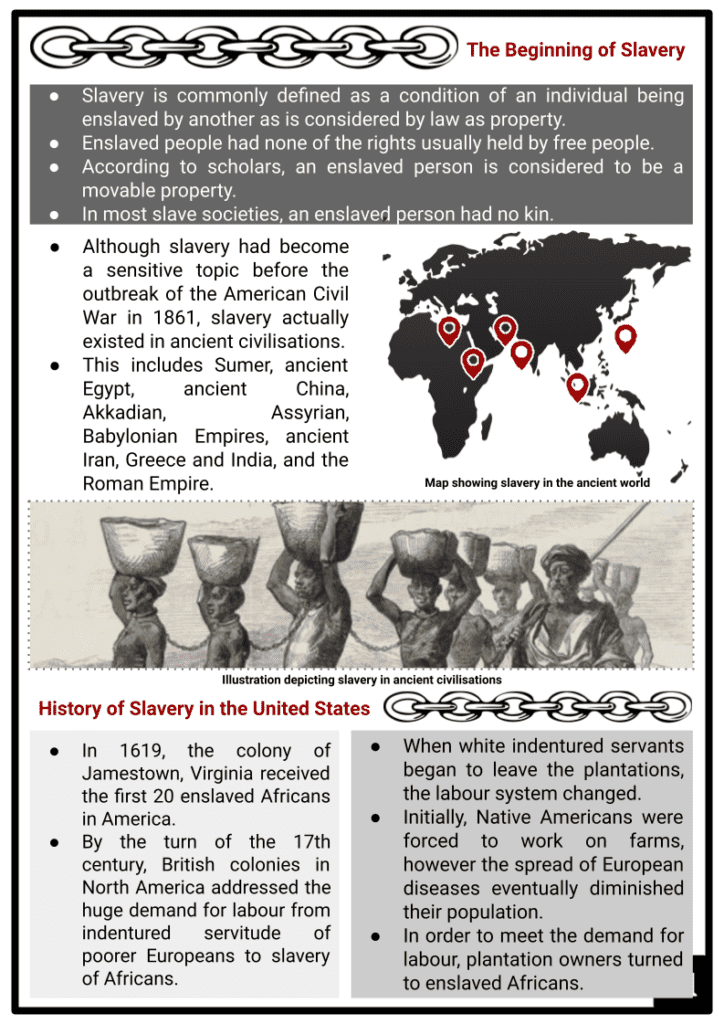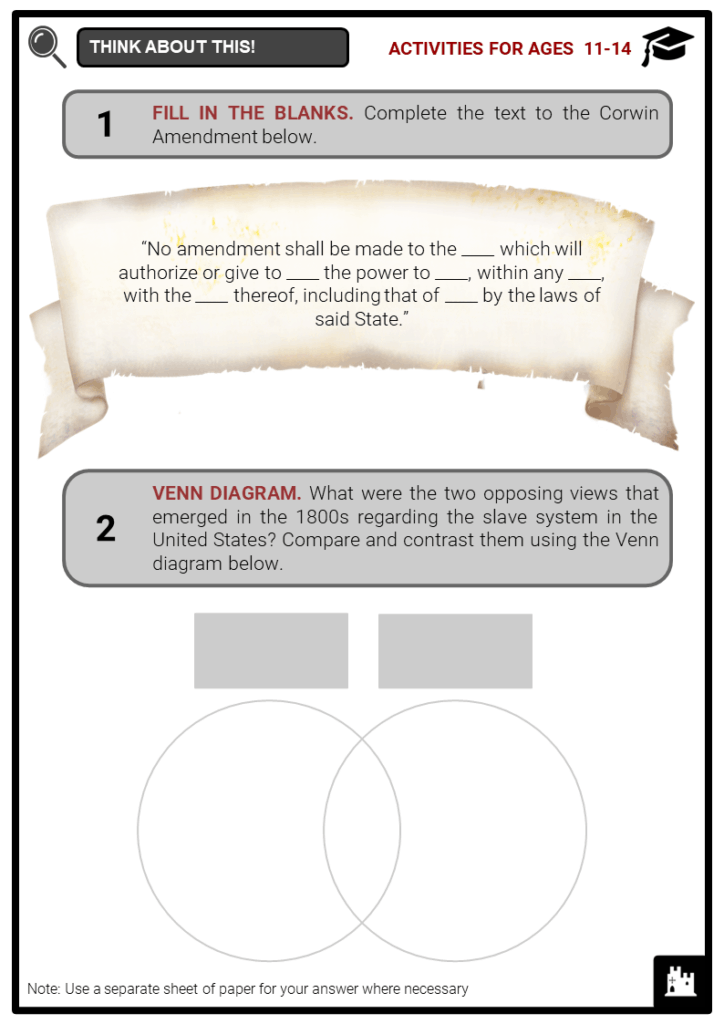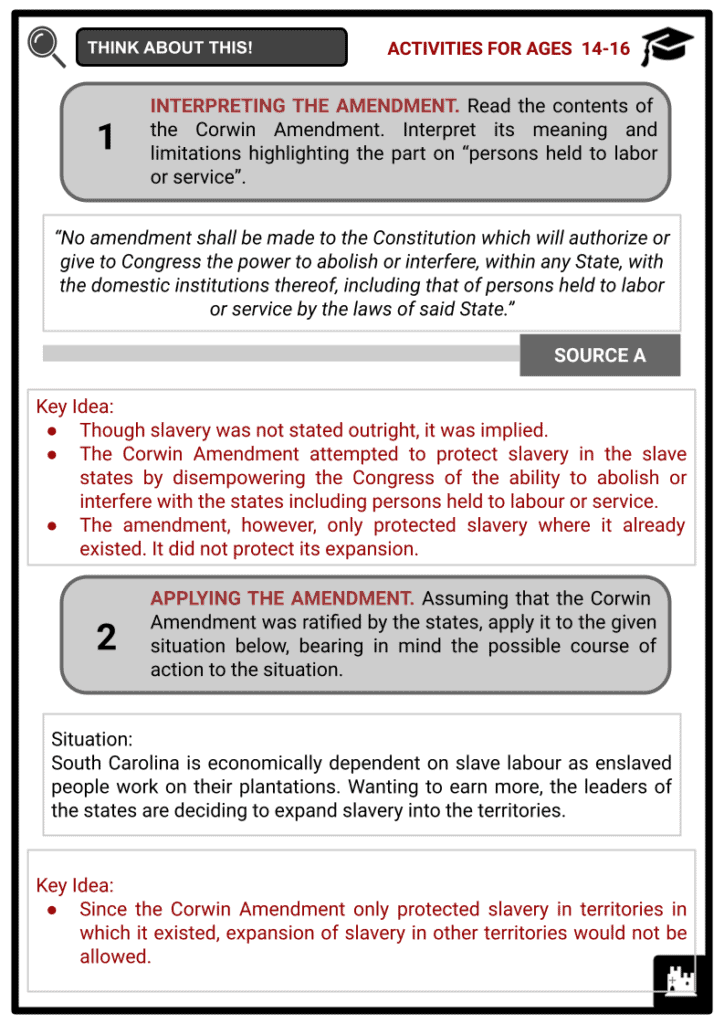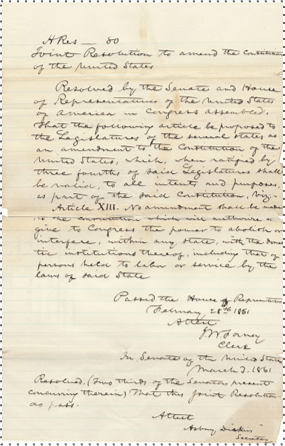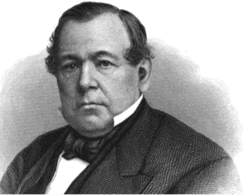Download The Corwin Amendment Worksheets
Do you want to save dozens of hours in time? Get your evenings and weekends back? Be able to teach The Corwin Amendment to your students?
Our worksheet bundle includes a fact file and printable worksheets and student activities. Perfect for both the classroom and homeschooling!
Table of Contents
Add a header to begin generating the table of contents
Summary
- Historical background on slavery
- Legislative history of the Corwin Amendment
- Presidential reactions to the Amendment, particularly James Buchanan and Abraham Lincoln
- The text of the amendment
- Aftermath, possibilities and failures of the amendment
Key Facts And Information
Let’s know more about The Corwin Amendment!
- The Corwin Amendment, also referred to as the Slavery Amendment of 1861, was one of the ‘Ghost Amendments’ of the United States that was passed by Congress but never ratified by the states.
- The primary objective of the amendment was to prevent the federal government from ever abolishing slavery in states where it existed at the time. It was hoped that the amendment would pacify states yet to secede from the Union and avert a Civil War already in the offing.
The Beginning of Slavery
- Slavery is commonly defined as a condition of an individual being enslaved by another as is considered by law as property.
- Enslaved people had none of the rights usually held by free people.
- According to scholars, an enslaved person is considered to be a movable property.
- In most slave societies, an enslaved person had no kin.
- Although slavery had become a sensitive topic before the outbreak of the American Civil War in 1861, slavery actually existed in ancient civilisations.
- This includes Sumer, ancient Egypt, ancient China, Akkadian, Assyrian, Babylonian Empires, ancient Iran, Greece and India, and the Roman Empire.
History of Slavery in the United States
- In 1619, the colony of Jamestown, Virginia received the first 20 enslaved Africans in America.
- By the turn of the 17th century, British colonies in North America addressed the huge demand for labour from indentured servitude of poorer Europeans to the slavery of Africans.
- When white indentured servants began to leave the plantations, the labour system changed.
- Initially, Native Americans were forced to work on farms, however, the spread of European diseases eventually diminished their population.
- In order to meet the demand for labour, plantation owners turned to enslaved Africans.
- In 1750, there were about 235,000 enslaved Africans, 85% of which lived in the South. With the expansion of the slave trade, plantation farming also grew, specifically in South Carolina and Georgia.
- Enslaved Africans who arrived in the American colonies brought knowledge of cultivating tobacco and rice crops since colonists knew little about this.
- The enslaved people were primarily engaged in agriculture, which was the backbone of the Southern economy.
- They made up a tenth of the total Southern population in 1680 and grew to a third by 1790.
- Aside from being suited to the tropical climate, enslaved Africans had skills in crop cultivation.
- Moreover, unlike American Indians, Africans had some immunity to tropical diseases like malaria and yellow fever.
Opposing Views on Slavery
- However, as the young American nation was establishing itself, political and legal thought shifted and institutions evolved in a manner that facilitated the slave system until its eventual abolition in 1865 by the Thirteenth Amendment.
- Two opposing views emerged: The Northern states, or the Union, who were more industrialised and were anti-slavery, and the Southern states, or the Confederacy, who were economically dependent on plantations and were pro-slavery.
THE UNION
- Geographically had bays and harbours good for fishing and shipbuilding industries.
- Economy was more industrialised, thus less dependent on slave labour.
- Growing abolitionist movement and anti-slavery sentiments.
- Consisted of 20 free states which were California, Illinois, Iowa, Minnesota, Maine, New Jersey, New Hampshire, Rhode Island, Oregon, Wisconsin, Connecticut, Pennsylvania, Indiana, Kansas, New York, Nevada, Vermont, Ohio, Michigan and West Virginia
THE CONFEDERACY
- Geographically had swamps and marshes suitable for agriculture.
- Highly dependent on plantations, so needed more enslaved people for cheaper labour.
- Pro-slavery society.
- The original seven Southern states were South Carolina, Mississippi, Alabama, Florida, Georgia, Louisiana and Texas, followed by the Upper South (Virginia, Tennessee, Arkansas and North Carolina).
Increasing tensions between Southern and Northern states over slavery and the election of Abraham Lincoln as the 16th president of the United States resulted in the outbreak of the Civil War.
Legislative History of the Corwin Amendment
- Upon Abraham Lincoln’s successful election to the Presidency in 1860, seven slaveholding states beginning with South Carolina seceded from the Union, owing to the President elect’s opposition to the institution of slavery.
- The states formed the Independent Confederate States of America, or Confederacy. This was during the 16 weeks between Lincoln’s election on 6 November 1860, and his inauguration on 4 March 1861.
- President James Buchanan, who was still in office at the time, pending Lincoln’s inauguration, assured Southerners that the incoming Republican president would not undermine their properties, including the enslaved people.
- He, therefore, asked Congress to draft what he referred to as an “explanatory amendment” to the Constitution that would explicitly recognise state rights to allow slavery.
- In response to the President’s request, a 33-member committee of the House of Representatives under the leadership of Representative Thomas Corwin of Ohio (whose amendment was later named after him) prepared a draft and presented it to the House.
- The amendment, designated as Joint Resolution No. 80, passed by a vote of 133 to 65 in the House of Representatives and 24 to 12 in the Senate on 28 February and 2 March 1861 respectively.
- It realised the two-thirds majority requirement, despite the seven states that had already decided to cede, not voting.
Presidential Reactions to the Corwin Amendment
- President Buchanan signed the amendment even though no presidential signature or assent was required for joint resolutions such as the amendment.
- He hoped that his signature would help secure the support of the Southern states in the ratification of the amendment.
- President Lincoln did not oppose the amendment once he took office, but also did not give it his specific support and transmitted the amendment to the states for their ratification.
- Only Ohio and Maryland, followed by Kentucky, Rhode Island and Illinois, ratified it. Ohio and Maryland rescinded their actions in 1864 and 2014, respectively.
- In a letter to Horace Greeley, Lincoln explained his reasons behind supporting the amendment as well as his position on slavery. He states:
- “My paramount object in this struggle is to save the Union and is not either to save or to destroy slavery. If I could save the Union without freeing any slave I would do it, and if I could save it by freeing all the slaves I would do it; and if I could save it by freeing some and leaving others alone, I would also do that. What I do about slavery, and the coloured race, I do because I believe it helps to save the Union; and what I forbear, I forbear because I do not believe it would help to save the Union. I shall do less whenever I shall believe what I am doing hurts the cause, and I shall do more whenever I shall believe doing more will help the cause. I shall try to correct errors when shown to be errors, and I shall adopt new views so fast as they shall appear to be true views. I have here stated my purpose according to my view of official duty; I intend no modification of my oft-expressed personal wish that all men everywhere could be free.”
The Text of the Corwin Amendment
- As with the Founding Fathers of the United States Constitution, slavery was not stated outright in the Corwin Amendment. However, it was assumed to be included. The amendment read as follows:
- “No amendment shall be made to the Constitution which will authorize or give to Congress the power to abolish or interfere, within any State, with the domestic institutions thereof, including that of persons held to labor or service by the laws of said State.”
Aftermath, Possibilities and Failures of the Corwin Amendment
- The resolution provided that the amendment would be made part of the constitution upon its ratification by three-fourths of the states.
- It further placed no time limit on the ratification process, meaning that even to this day, it can still be ratified by the states. However, such a move would be entirely out of tune with the dynamics of present-day America.
- Had the amendment been ratified by the states before the Civil War and the Emancipation Proclamation, it would have been the Thirteenth Amendment protecting slavery, as opposed to the present-day Thirteenth Amendment abolishing it.
- However, the amendment failed because, after decades of hostilities and debates concerning slavery, the South did not trust the North.
- The Northern states were restricting slavery in the Western states and refused to admit new slaveholding states into the Union.
- The amendment was thus, a “too little too late” kind of political manoeuvre.
Image sources:


